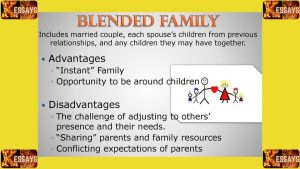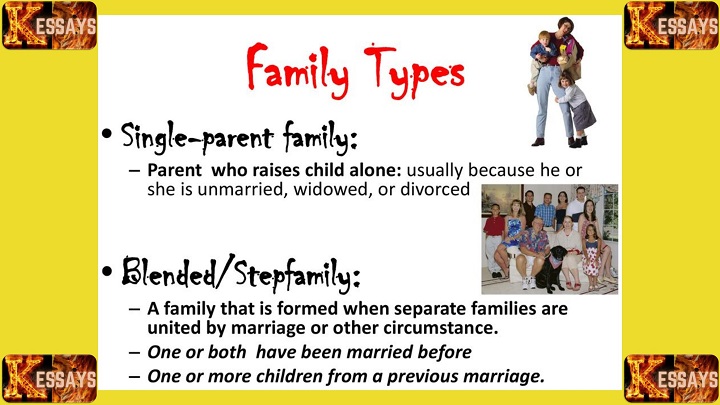Introduction
The study of types of family units serves as a crucial lens through which we can comprehend the intricate dynamics and diverse structures that define human relationships. In the realms of sociology, social work, and psychology, the term "types of family units" encompasses a broad spectrum of familial configurations, each with its unique attributes and societal implications. This
essay aims to provide a comprehensive exploration of the multitude of family structures, shedding light on their classifications, functions, and roles within the broader social context.
Defining Types of Family Units
The exploration of family structures within the realm of sociology is a multifaceted endeavor that unveils a spectrum of nuanced relationships and configurations. In this
comprehensive discussion, we discern and delineate the characteristics of four primary types of family units: nuclear families, extended families, single-parent families, and childless families.
Nuclear Families:
The nucleus of familial dynamics, nuclear families represent a paradigmatic structure characterized by the cohabitation of two parents and their children within a singular household. This archetype emphasizes autonomy and the cultivation of close-knit relationships within the immediate family unit. The nuclear family serves as a microcosm where individual roles and responsibilities contribute to the holistic development of its members.
Extended Families:
In stark contrast, extended families transcend the confines of the nuclear unit, engendering a broader network that incorporates not only parents and children but also grandparents, aunts, uncles, and cousins. This expansive
familial structure underscores the interconnectedness of generations, fostering shared responsibilities and intergenerational connections. Within extended families, the familial bond extends beyond the immediate nuclear unit, creating a rich tapestry of relationships that weaves through multiple generations.

Single-Parent Families:
The emergence of single-parent families encapsulates a poignant narrative of resilience and adaptability within the intricate landscape of family units in social work. This family type materializes when one parent assumes the primary caregiving role, navigating the complexities of parenting independently. This structure illuminates the strength and resourcefulness of single individuals who courageously confront the challenges of
parenthood, often demonstrating a remarkable ability to adapt and provide for their children's needs.
Childless Families:
Challenging conventional narratives, childless families purposefully prioritize the bond between partners over parenthood. This intentional choice reflects a family structure that transcends biological ties, placing emphasis on shared life experiences and mutual support. Childless families contribute to the evolving narrative of family dynamics by showcasing that familial bonds can be deeply meaningful and fulfilling beyond the traditional framework of parent-child relationships.
In examining these types of family units, it becomes evident that each configuration plays a unique role in shaping societal structures and contributing to the rich diversity of human relationships. The intricate interplay of individual roles, societal expectations, and cultural influences within these family structures creates a dynamic tableau that underscores the fluidity and adaptability inherent in the ever-evolving landscape of
family life.
Exploring Diverse Family Structures
Venturing beyond the foundational four types, the landscape of family structures unfolds into a rich tapestry, revealing a nuanced array of classifications. In the expansive realm of sociology, seven distinctive family structures come to the fore, offering profound insights into the intricate complexities of familial relationships.
Stepfamilies:
Stepfamilies materialize through the union of individuals in remarriage, seamlessly incorporating individuals with children from previous relationships. This intricate family structure navigates the complexities of blended families, where adaptability becomes paramount. Stepfamilies exemplify the negotiation of new roles, highlighting the resilience and flexibility required to forge cohesive bonds in the face of diverse backgrounds and histories.
Same-Sex Families:
Challenging and transcending traditional gender norms, same-sex families stand as a testament to the evolving landscape of family units in sociology. Comprising same-sex couples and their children, these families become pioneers in reshaping societal norms. Their existence not only underscores the diversity within family structures but also emphasizes the universal
principles of love and commitment. Same-sex families contribute significantly to fostering inclusivity and expanding the understanding of what constitutes a family, challenging preconceived notions and fostering a more accepting society.
Multigenerational Families:
Within the realm of diverse family structures, the concept of multigenerational families emerges, embracing a configuration where multiple generations cohabit under one roof. This structure fosters a unique interplay of wisdom, experience, and the dynamic energy of youth, creating a microcosm of shared history and interdependence.
Cohousing Communities:
Breaking away from traditional family structures, cohousing communities represent an innovative approach where families or individuals with a shared vision come together to form intentional communities. In these communities, residents actively participate in decision-making processes, shared responsibilities, and a sense of collective well-being. The fluidity and adaptability within these structures challenge conventional notions of familial relationships, highlighting the potential for non-traditional configurations to thrive.
Single-Person Households:
In the spectrum of diverse family structures, the prevalence of single-person households has become increasingly prominent. This configuration emphasizes individual autonomy and self-sufficiency, reflecting a lifestyle choice that prioritizes independence and personal growth. The rise of single-person households reflects evolving societal norms, where individuals seek fulfillment and connection beyond traditional familial structures.
Transnational Families:
As societies become more interconnected globally, transnational families have emerged as a distinctive family structure. These families span geographical boundaries, with members residing in different countries. The challenges and opportunities within transnational families underscore the impact of globalization on familial relationships, raising questions about identity, cultural preservation, and the redefinition of traditional family ties.
Child-Headed Families:
A poignant reflection of societal challenges, child-headed families arise when children take on the role of primary caregivers due to various circumstances, such as the loss of parents or family disruption. This unique family structure emphasizes the resilience and adaptability of children facing adversity, shedding light on the
importance of community support and intervention in fostering the well-being of these families.
In the exploration of diverse family structures, the complexities and richness of human relationships come to the forefront. Each configuration brings forth unique challenges, opportunities, and perspectives, contributing to the ever-evolving narrative of familial bonds in contemporary society.

The Family Unit System: Navigating Categories and Psychological Dimensions
To grasp the intricacies of familial structures, it is imperative to delve into the categories within the family unit system. Sociology provides a foundational understanding of the four primary types, while psychology offers a nuanced exploration of the emotional and psychological dimensions embedded within familial relationships.
Categories Within the Family Unit System: A Sociological Perspective
In sociology, the family unit system is categorized into four primary types: nuclear families, extended families, single-parent families, and childless families. Each type represents a distinctive configuration, shaping the nature of
interpersonal relationships and societal dynamics. This sociological lens allows for a comprehensive examination of how family structures contribute to the fabric of social institutions.
Psychological Dimensions of Family: An In-Depth Exploration
The psychological exploration of family units extends beyond sociological categorizations, delving into the intricate emotional and psychological dynamics that characterize familial relationships. Within the family unit system,
psychology emphasizes the profound impact of these structures on individual well-being. This lens highlights the interconnectedness of mental health and the intricate tapestry of familial bonds.
In the realm of psychology, familial relationships are viewed as dynamic entities that significantly influence the psychological well-being of individuals. The family unit serves as a crucible for the development of emotional resilience, interpersonal skills, and coping mechanisms. Moreover, the psychological dimensions of family delve into the intricacies of how familial dynamics shape one's self-perception, identity formation, and overall mental health.
Interconnectedness of Mental Health and Familial Bonds: A Psychological Perspective
Psychology underscores the symbiotic relationship between mental health and familial bonds. Positive family dynamics, characterized by support, communication, and emotional validation, contribute to the psychological well-being of individuals. Conversely, dysfunctional family structures may pose challenges to mental health, manifesting in issues such as anxiety, depression, or interpersonal difficulties.
Understanding the
psychological dimensions within the family unit system involves recognizing the influence of familial interactions on cognitive processes, emotional regulation, and overall psychological resilience. As individuals navigate the complexities of familial relationships, psychologists emphasize the importance of fostering healthy communication patterns, establishing boundaries, and promoting a supportive familial environment.
In conclusion, the family unit system encompasses both sociological categorizations and psychological dimensions. Sociology provides a framework for understanding the structural diversity of familial configurations, while psychology delves into the intricate emotional and psychological dynamics that shape individual well-being within these structures. Together, these perspectives offer a comprehensive understanding of the multifaceted nature of familial relationships and their impact on the broader social and psychological landscape.

Conclusion
In conclusion, the exploration of types of family units unveils a rich and intricate tapestry woven from the threads of diverse human relationships. The term "types of family units" encapsulates a comprehensive array of structures, each contributing to the dynamic narrative of familial configurations. From the foundational nuclear families to the evolving landscapes of stepfamilies and same-sex families, this exploration transcends mere categorizations; it delves into the very fabric of
societal norms and individual experiences.
Sociology, social work, and psychology collectively serve as our guiding lights in navigating the complexities inherent in these familial configurations. Sociology lays the groundwork, providing a structural framework for understanding the diverse family types that shape our social landscape. Social work, in turn, becomes the bridge that connects theory to real-world applications, navigating the challenges and opportunities embedded within family dynamics. Psychology adds depth to our understanding, unraveling the emotional and psychological dimensions that intricately influence the human experience within these familial structures.
The recognition and acknowledgment of the diversity inherent in family structures are imperative for fostering inclusivity, empathy, and a nuanced understanding of the various ways individuals form meaningful connections within the intricate web of human society. Embracing this
diversity allows us to move beyond stereotypes, challenging preconceived notions, and cultivating a society that values and respects the myriad ways in which families are formed and sustained.
In essence, the exploration of types of family units goes beyond a mere academic exercise; it is a journey into the heart of human connections, where the threads of love, resilience, and shared experiences weave a tapestry that is as unique as each family it represents. As we navigate this ever-evolving landscape, let us approach it with open minds, compassionate hearts, and a commitment to fostering a world where every family type is celebrated and embraced.



